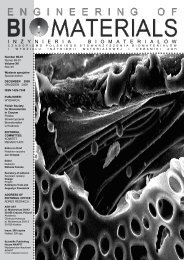69-72 - Polskie Stowarzyszenie BiomateriaÅów
69-72 - Polskie Stowarzyszenie BiomateriaÅów
69-72 - Polskie Stowarzyszenie BiomateriaÅów
You also want an ePaper? Increase the reach of your titles
YUMPU automatically turns print PDFs into web optimized ePapers that Google loves.
Mikroskopowa ocena<br />
przylegania brzeżnego<br />
wypełnień w zębach stałych<br />
Mariusz Walczak 1 *, Agata Niewczas 2 *<br />
1<br />
Instytut Technologicznych Systemów Informacyjnych,<br />
Politechnika Lubelska<br />
2<br />
Katedra i Zakład Stomatologii Zachowawczej,<br />
Akademia Medyczna w Lublinie<br />
*e-mail: m.walczak@pollub.pl<br />
Streszczenie<br />
Prezentowana praca dotyczy badań szczelności<br />
brzeżnej wypełnień z amalgamatu srebra oraz<br />
kompozytu światłoutwardzalnego w warunkach<br />
laboratoryjnych (in vitro). Do badań wykorzystano<br />
zęby ludzkie trzonowe i przedtrzonowe usunięte ze<br />
względów ortodontycznych, w których wypreparowano<br />
ubytki klasy I wg. Blacka. Próbki zębów z założonymi<br />
wypełnieniami poddano zaprogramowanym cyklom<br />
obciążeń mechanicznych na specjalnie zbudowanym<br />
urządzeniu testującym, symulującym fizjologiczny tor<br />
ruchu żuchwy. Następnie oceniano obszar połączenia<br />
materiału wypełnienia z tkanką twardą zęba na mikroskopie<br />
skaningowym. Na każdej próbce stwierdzono<br />
obecność szczeliny brzeżnej wynoszącej od kilku do<br />
kilkunastu µm.<br />
[Inżynieria Biomateriałów, <strong>69</strong>-<strong>72</strong>, (2007), 87-89]<br />
Wprowadzenie<br />
W rekonstrukcji ubytków uzębienia stosuje się szereg materiałów<br />
metalowych i niemetalowych, których zadaniem jest<br />
zapewnienie trwałego połączenia materiału odtwórczego<br />
z pierwotną strukturą zęba. W grupie materiałów metalowych,<br />
do wypełnień w zębach bocznych nadal stosuje się<br />
amalgamat, chociaż w dużej mierze wypierany jest on przez<br />
coraz nowsze generacje materiałów ceramiczno-polimerowych<br />
[1]. Chociaż materiały kompozytowe odznaczają się<br />
lepszą estetyką, to jednak stosowanie ich w zastępstwie<br />
amalgamatów jest ograniczone ze względu na wysoki koszt<br />
takich wypełnień oraz mniejszą trwałość [2].<br />
W celu zapewnienia trwałego połączenia materiału<br />
wypełnienia z twardymi tkankami zęba, materiał odtwórczy<br />
powinien charakteryzować się dobrą adhezją, a kliniczne<br />
miejsce przejścia wypełnienia w szkliwo powinno być gładkie<br />
z zachowaną w pełni ciągłością [3,4]. Zdarza się, że połączenie<br />
to ulega uszkodzeniu i dochodzi wówczas powstania<br />
szczelin brzeżnych [4]. Wówczas w mikroszczelinach może<br />
dochodzić do szeregu powikłań: powstania próchnicy wtórnej,<br />
nadwrażliwości, zapalenia miazgi a w efekcie końcowym<br />
do przedwczesnego uszkodzenia wypełnienia lub struktury<br />
pierwotnej zęba [3,4].<br />
Duży wpływ na szczelność połączenia tkanki zęba<br />
z materiałem kompozytowym ma m. in. skurcz polimeryzacyjny,<br />
współczynnik rozszerzalności cieplnej, mikropęknięcia<br />
w obrębie szkliwa, rodzaj systemów łączących oraz sposób<br />
przygotowania miejsca pod wypełnienie [3-5].<br />
W artykule podjęto próbę oceny nieszczelności brzeżnej<br />
wypełnień z amalgamatu srebra oraz kompozytu światłoutwardzalnego<br />
metodą „in vitro”. Przedmiotem badań<br />
była mikrostruktura połączenia materiałów odtwórczych<br />
z tkanką zęba.<br />
Microscopic evaluation of<br />
the marginal adhesion of<br />
the fillings in permanent<br />
teeth<br />
Mariusz Walczak 1 *, Agata Niewczas 2 *<br />
1<br />
Institute of Technological Systems of Information,<br />
Lublin University of Technology<br />
2<br />
Chair and Department of Protective Dentistry,<br />
University School of Medicine in Lublin<br />
*e-mail: m.walczak@pollub.pl,<br />
Abstract<br />
The presented work deals with the study of the<br />
marginal tightness of the amalgam and light-setting<br />
composite fillings in laboratory conditions (in vitro).<br />
Human molars and premolars extracted due to orthodontic<br />
reasons were used in the study. In those teeth<br />
the class I cavities according to Black’s classification<br />
were prepared. The tooth specimens with fillings were<br />
submitted to the programmed cycles of mechanical<br />
loads in the specially designed investigation station<br />
simulating the physiological trajectory of the mandible.<br />
The next stage constituted the scanning microscopic<br />
evaluation of the area of the bond between the filling<br />
material and hard tissue. The presence of an edge<br />
fissure of the size from a few to a dozen or so μm was<br />
observed in each specimen.<br />
[Engineering of Biomaterials, <strong>69</strong>-<strong>72</strong>, (2007), 87-89]<br />
Introduction<br />
Numerous metal and non-metal materials are used in<br />
tooth reconstruction. Their aim is to provide and ensure the<br />
durable bond between the reconstructing material and the<br />
primary tooth structure. As far as the group of metal materials<br />
is concerned, amalgam is still being used in the marginal<br />
fillings however, it is being replaced with new generations<br />
of ceramic and polymer materials [1]. Although composite<br />
materials are characterized by better esthetics, their use<br />
instead of amalgam is limited due to high cost and lesser<br />
durability [2].<br />
In order to ensure a durable bond between a filling and<br />
hard tissue, the material should be characterized by good<br />
adhesion and clinical area of the passage of a filling into<br />
the enamel must be smooth and must constitute the full<br />
continuity [3,4]. It may occur that such a bond undergoes<br />
some damage resulting in the arising of edge fissures [4].<br />
In such a case, numerous complications may occur such<br />
as secondary caries, oversensitivity, pulpitis and finally, it<br />
may lead to the damage of a filling or the primary tooth<br />
structure. [3,4].<br />
A considerable influence on the bond of tooth tissue and<br />
composite material is exerted by polymerization spasm,<br />
coefficient of thermal expansion, microcracks in the area<br />
of the enamel, a type of bonding system and the way the<br />
cavity to be filled was prepared [3-5].<br />
In this article the attempt was made to evaluate the marginal<br />
untightness of silver amalgam fillings and light-setting<br />
composite fillings by means of ‘in vitro’ method. The subject<br />
of the investigation was the microstructure of the bond between<br />
reconstructing materials and tooth tissue.<br />
87













